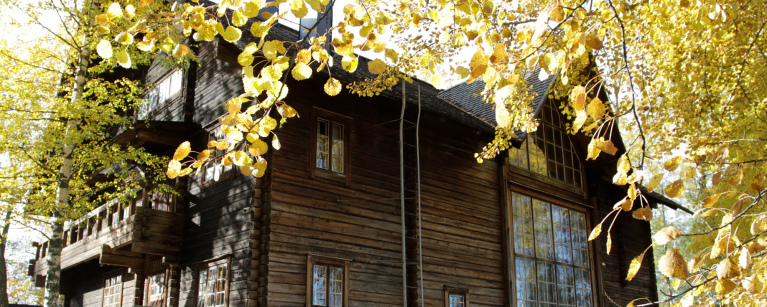Halosenniemi in English
Halosenniemi museum – Home of Painter Pekka Halonen
Finnish painter Pekka Halonen was born in 1865, in the same year as composer Jean Sibelius and painter Akseli Gallen-Kallela. Later on, it was evident that this year was of great importance for the cultural life in Finland.
Pekka Halonen was born in Lapinlahti, Central Finland. His father was a farmer, who also painted decorative art around the neighbourhood churches. Pekka used to follow him to his painting trips, and in this way learned a great deal about decorative art. His musical talents were inherited from his mother, who played violin and the Finnish national instrument, kantele.
Halonen studied at the Finnish Art Society's Art School in Helsinki for four years. After completing his studies in Helsinki in 1890, he had the chance to continue his studies in Paris, the capital of art. There he spent four winters studying at two renowned art academies, Académie Julian and Académie Colarossi. He was also one of the private students of the famous French artist Paul Gauguin in 1894. From Gauguin he absorbed the interest in colours and nature. Afterwards he completed his studies in Italy. He travelled to Florence, Venice, Rome, and Naples. On his travels around Italy he became inspired by ancient Roman art and the early Renaissance frescoes.
In the 1890s, Halonen took painting trips to Karelia, the Eastern part of Finland. One of those trips became very important for him, because there he met his future wife Maija Mäkinen. In 1895, they got married and their first son was born in 1896. Over time, Pekka and Maija were blessed with four sons and four daughters.
Halonen had a little studio in Helsinki, but the hustle and bustle of the city life was not for him. His good friend, author Juhani Aho had moved beside Lake Tuusula with his family in 1897. He and his wife, painter Venny Soldan-Brofelt recommended the town of Tuusula to Halonen. The family Halonen arrived to Tuusula in 1898 and lived in three different farmhouses near the lake, before they found the final place for their home. Pekka and Maija found this narrow and rocky cape on one of their skiing trips and here they decided to build their own studio-home.
Constructions of Halosenniemi began in the spring of 1900. Pekka Halonen designed the house, and his brother Antti worked as the constructer. Red pine wood used as the building material was brought from the Central Finland by rail. The massive logs were pulled by horses over the ice of Lake Tuusula from the Järvenpää railway station.
Halosenniemi was completed in 1902. The house has seven rooms and a kitchen. There is also an attic and a room in the basement. Halonen designed the fireplaces and his cousin Arttu Halonen forged the oven doors, which can be seen as reflections of the purposes and the general atmosphere of the rooms. A grouse spreads her wings and welcomes all the visitors to Halosenniemi in the oven door of the entrance hall. A woman warming herself by the fireplace in the studio gives an idea of the cosiness and the relaxed atmosphere of Halosenniemi. In the dining room, a mother pig feeds her seven little piglets. The children of Halonen saw this as their family portrait (mother Maija and all the children) because at that time the family Halonen had seven children. When the eighth child was born in 1918, the other children decided to add one more piglet on the door. Still today, the "extra piglet" lies in the mother's armpit.
Apart from being a workspace for Pekka Halonen, the studio served as the living room for the artist community of Lake Tuusula. Thanks to its marvellous acoustics, numerous house concerts and chamber music evenings were held in Halosenniemi. The composer Robert Kajanus chose a beautifully toned Steinway piano for Maija Halonen, who had studied as a piano teacher and she often played background music while her husband was working. Sibelius's wife, Aino, often played duets with Maija.
Maija was a hardworking and skilled woman. After putting her children to bed, she started to sew their clothes and sometimes translate literature from Italian, Norwegian, Swedish and German into Finnish. Maija Halonen made the first Finnish translation of Carlo Collodi's Pinocchio.
Pekka Halonen died at home in 1933. Maija lived in Halosenniemi eleven years after her husband and died in 1944. In 1949, Halosenniemi was sold to town Tuusula on the condition that it was made into a museum.
Pekka Halonen is one of the masters of the Golden Age in Finnish art. He participated in the 1900 Paris Exhibition and won the second prize. Halonen is well-known for his winter landscapes, but also as a portrayer of the Finnish common folk in the politically difficult times of the 1890s.


